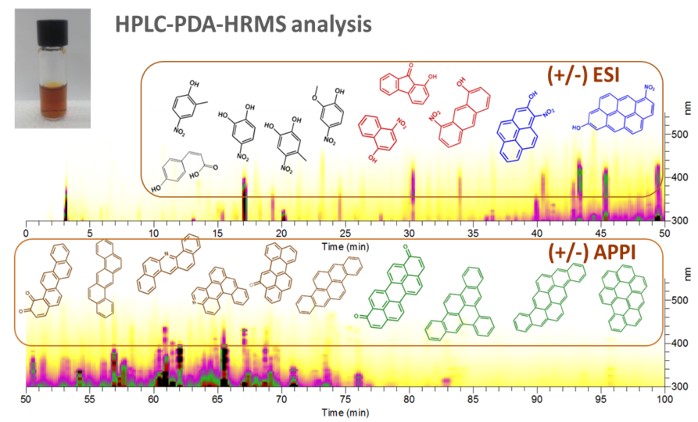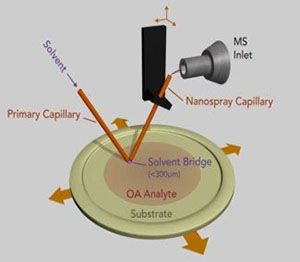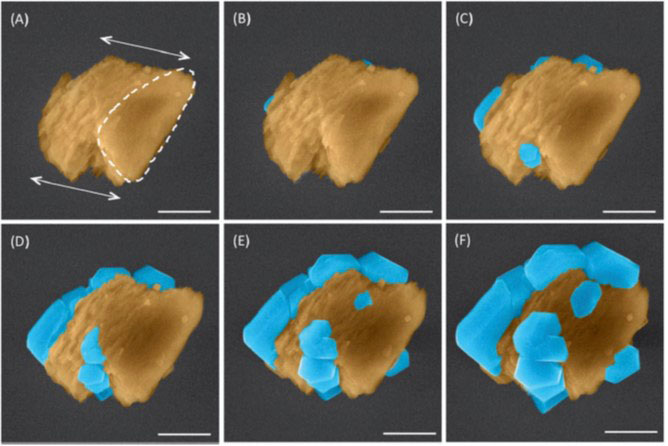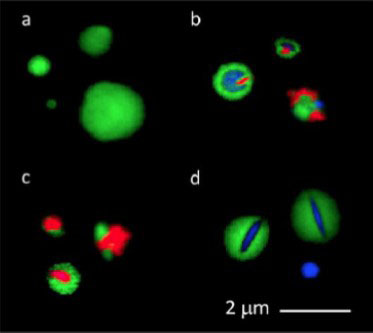Past Novel Measurements
Comprehensive Molecular Characterization of Atmospheric Brown Carbon
Light-absorbing components of atmospheric organic aerosols, which are collectively termed "brown carbon" (BrC) are ubiquitous in the atmosphere. Understanding the sources, transformations and environmental effects of BrC requires molecular identification and characterization of light-absorption properties of BrC chromophores. We employ complementary ionization techniques to obtain broad coverage of polar and non-polar BrC components using high-resolution mass spectrometry. We combine these techniques with chromatographic separation of BrC compounds followed by tandem measurements of their light absorption properties and chemical composition. Combined together, they enable comprehensive characterization of BrC in aerosol samples.

Image caption: an example of HPLC-PDA chromatogram of organic aerosol containing light absorbing components (BrC chromophores). Molecular structures depict selected species detected in ESI and APPI ionization modes, respectively.
Relevant publications
P. Lin, L. T. Fleming, S. A. Nizkorodov, J. Laskin, A. Laskin. Comprehensive Molecular Characterization of Atmospheric Brown Carbon by High Resolution Mass Spectrometry with Electrospray and Atmospheric Pressure Photoionization. Analytical Chemistry, (2018). In review
P. Lin, J. Laskin, S. Nizkorodov, A. Laskin Revealing Brown Carbon Chromophores Produced in Reactions of Methylglyoxal with Ammonium Sulfate. Environmental Science and Technology, 49, 14257−14266, (2015). doi: 10.1021/acs.est.5b03608.
Desorption/Ionization of Substrate Deposited Aerosols
partnership with J. Laskin (Purdue University)
We co-developed a novel surface ionization technique, nanospray desorption electrospray ionization (nano-DESI) and demonstrated its utility for rapid and sensitive (<10ng) analysis of both laboratory and field collected aerosol samples. In nano-DESI, the analyte deposited on a substrate is probed by an online liquid extraction followed by nanoelectrospray ionization. Nano-DESI enables fast and efficient collection, ionization, and transfer of analyte resulting in a significant improvement of detection limits as compared to other ambient ionization methods, and requires no special sample preparation or pretreatment. Reactive nano-DESI-MS experiments, where specific reactant is blended into the working solvent, allows examining the presence of molecules with certain functional groups and quantification of these compounds within complex matrix of aerosol mixtures.

Image caption: Schematics of the sample introduction and ionization setups used in nanospray desorption electrospray ionization (nano-DESI) analysis of organic aerosol (OA) samples.
Relevant publications
J. Laskin, P.A. Eckert, P.J. Roach, B.S. Heath, S.A. Nizkorodov, A. Laskin Chemical Analysis of Complex Organic Mixtures Using Reactive Nanospray Desorption Electrospray Ionization Mass Spectrometry. Analytical Chemistry, 84, 7179-7187, (2012). doi: 10.1021/ac301533z
P.J. Roach, J. Laskin, A. Laskin Molecular Characterization of Organic Aerosols Using Nanospray Desorption Electrospray Ionization Mass Spectrometry. Analytical Chemistry, 82, 7979–7986, (2010). doi: 10.1021/ac101449p.
Observing Ice Nucleation Events in Environmental Scanning Electron Microscope
partnership with B. Wang (Xiamen University) and D.A. Knopf (Stony Brook University)
We assembled a novel experimental platform for direct observation of ice nucleation events on individual particles complemented by micro-spectroscopic analysis of particle composition. This platform utilizes a custom-built ice nucleation cell, interfaced with an Environmental Scanning Electron Microscope (IN-ESEM platform) operated at temperatures and relative humidity relevant for heterogeneous ice nucleation in cirrus clouds. The IN-ESEM platform allows dynamic observations of individual ice formation events over particles in isobaric and isothermal experiments allowing experimental studies of ice crystal growth and morphology under a wide range of thermodynamic conditions. The IN-ESEM platform provides a new experimental tool to probe effects on the nanoscale of various materials in response to low temperatures and concomitant variation in RH with previously unachieved precision and resolution.

Image caption: A series of false colored IN-ESEM images showing heterogeneous nucleation of ice crystals (blue) on an individual kaolinite particle (brown) at 205.4 K and 124.2% RHice
Relevant publication
B. Wang, D. A. Knopf, S. China, B. W. Arey, T. H. Harder, M. K. Gilles, A. Laskin. Probing Individual Ice Nucleation Events with Environmental Scanning Electron Microscopy. Physical Chemistry Chemical Physics, 18, 29721-29731, (2016). doi: 10.1039/C6CP05253.
Chemical Imaging of Particle Internal Composition, Mixing State and Transformations
partnership with R. Moffet (Sonoma Technologies, Inc.) and M. Gilles, (Lawrence Berkeley National Laboratory)
Variety of off-line analytical techniques for microscopy, micro-spectroscopy, and imaging mass spectrometry have been advanced by our group for unique applications to probe particle internal composition, their optical, hygroscopic and cloud-forming properties. We employ the multi-modal chemical imaging where complementary analytical capabilities of different techniques are coupled for in-depth particle analysis providing both external and internal mixing state characteristics. We collaborate with scientists at the Synchrotron Light Sources on the development of micro-reaction cells for X-ray spectro-microscopy and its applications for in-situ imaging of phase transitions and liquid-liquid phase separations in individual particles.

Image caption: Chemically specific STXM/NEXAFS images (maps) of individual particles with various internal composition (mixing states). Colors indicate the experimentally defined chemical components: green = organic carbon, red = black carbon, blue = inorganic salts.
Relevant publications
D.P. Veghte, S. China, L. Kovarik, J. Weiss, M.K. Gilles, A. Laskin. Optical Properties of Airborne Soil Organic Particles. ACS Earth and Space Chemistry, 1(8),511–521, (2017). doi: 10.1021/acsearthspacechem.7b00071
R. O’Brien, B. Wang, S. Kelly, N. Lundt, Y. You, A. Bertram, S. Leone, A. Laskin, R. Moffet, M. Gilles. Imaging of liquid-liquid phase separation in aerosol particles at nanometer scale. Environmental Science and Technology, 2015, 49, 4995−5002 (2015). doi: 10.1021/acs.est.5b00062
R. C. Moffet, T. Henn, A. Laskin, M.K. Gilles Automated Chemical Analysis of Internally Mixed Aerosol Particles Using X-ray Spectromicroscopy at the Carbon K-Edge, Analytical Chemistry, 82, 7906–7914, (2010). doi: 10.1021/ac1012909.
A. Laskin, J. P. Cowin, M. J. Iedema "Analysis of individual environmental particles using modern methods of electron microscopy and X-ray microanalysis" Journal of Electron Spectroscopy and Related Phenomena, 150, 260-274, (2006). doi: 10.1016/j.elspec.2005.06.008
